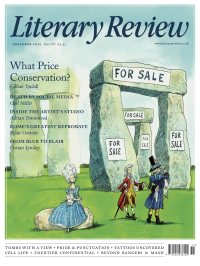Adrian Tinniswood
Think of the Live Models!
The Artist’s Studio: A Cultural History
By James Hall
Thames & Hudson 288pp £30
I have to confess to taking a voyeuristic pleasure in visiting the places where writers have produced their work. I’ve soaked up the atmosphere in Vita Sackville-West’s writing room, perched like an eyrie at the top of a tower at Sissinghurst. I’ve pressed my nose against the window of George Bernard Shaw’s revolving writing hut at the bottom of his garden in Ayot St Lawrence. I’ve channelled Churchill at Chartwell and rimed with the ancient mariner at Coleridge Cottage.
The art workshop is just as fascinating as the writer’s room; more so, in fact, because there one can usually see the tools used in the making, which are rather more interesting than a typewriter or a desk blotter. And best of all is when such places are still populated by makers. Think of the Minster Stoneyard in York, where a team of craftsmen and women shape gargoyles and finials in much the same way as their medieval forebears did (though with rather better saws and hoists, and modern dust extraction systems), or Hart Silversmiths in Chipping Campden, where you can watch as the descendants of C R Ashbee’s Guild of Handicraft still fashion everything from knives and forks to magnificent jewel-encrusted processional crosses (something of a niche market in this day and age, one feels).
The artist’s studio falls between the writing desk and the workbench, and it combines the best of both. It is a place where things have been made and where art – fine art – has been conceptualised, created and refined, and sometimes discarded. It might be a chic white box, a warehouse with paint-splattered walls or a back room in a terraced house with a decent north-facing window. Visitors to these places know that this painting or that statuette should stand alone, independent of its maker and the circumstances of its making, but can’t help themselves from reconstructing in imagination the act of creation.
James Hall’s The Artist’s Studio is a thorough exploration of artists’ workspaces. Billed as a cultural history, it combines cerebral and beautifully illustrated argument with encyclopedic information about artists, their working practices and their funny little ways. Hall starts early in time with Homer’s description in the Iliad

Sign Up to our newsletter
Receive free articles, highlights from the archive, news, details of prizes, and much more.@Lit_Review
Follow Literary Review on Twitter
Twitter Feed
It wasn’t until 1825 that Pepys’s diary became available for the first time. How it was eventually decrypted and published is a story of subterfuge and duplicity.
Kate Loveman tells the tale.
Kate Loveman - Publishing Pepys
Kate Loveman: Publishing Pepys
literaryreview.co.uk
Arthur Christopher Benson was a pillar of the Edwardian establishment. He was supremely well connected. As his newly published diaries reveal, he was also riotously indiscreet.
Piers Brendon compares Benson’s journals to others from the 20th century.
Piers Brendon - Land of Dopes & Tories
Piers Brendon: Land of Dopes & Tories - The Benson Diaries: Selections from the Diary of Arthur Christopher Benson by Eamon Duffy & Ronald Hyam (edd)
literaryreview.co.uk
Of the siblings Gwen and Augustus John, it is Augustus who has commanded most attention from collectors and connoisseurs.
Was he really the finer artist, asks Tanya Harrod, or is it time Gwen emerged from her brother’s shadow?
Tanya Harrod - Cut from the Same Canvas
Tanya Harrod: Cut from the Same Canvas - Artists, Siblings, Visionaries: The Lives and Loves of Gwen and Augustus John by Judith Mackrell
literaryreview.co.uk